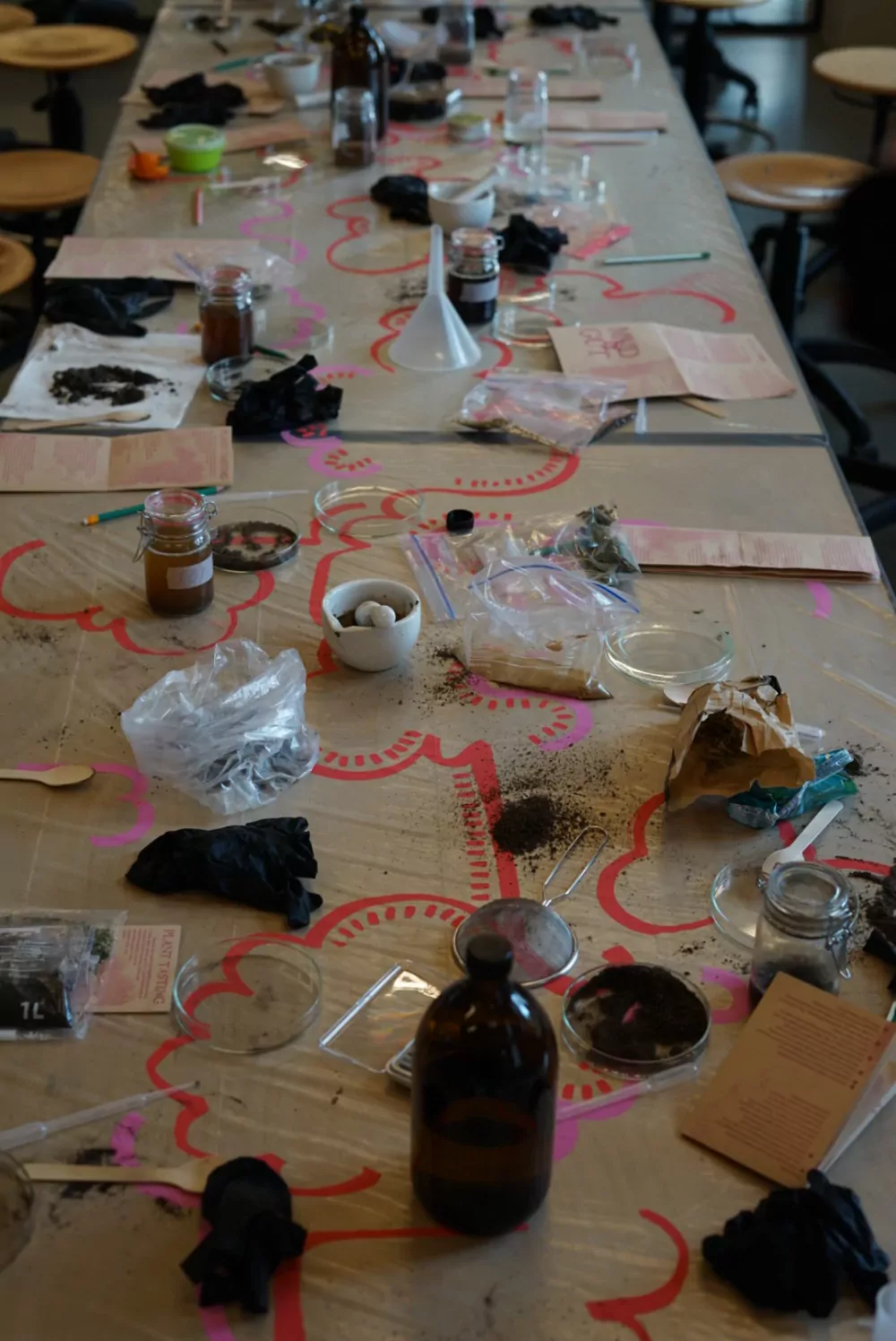Mud and Gut
Described by Josymar Rodriguez Alfonzo, Steffie De Gaetano, Liesbeth HuybrechtsDescription
|
Context: who/when/where
|
Who: Reworlding Network When: Kick-off meeting event Where: Bokrijk, Belgium. |
|
Description:
|
As part of the Reworlding network’s inaugural gathering, Mud & Gut invited participants to engage in a slow and sensorial exploration of digestion and indigestion as relational paths to their landscapes. This full-day workshop unfolded through a carefully designed protocol, bringing together sensory exploration, scientific technique, and storytelling with materials participants brought from their own environments: one soil sample and one plant companion each. These samples became companions through which participants could reflect on the ecological, political, and affective rifts in their landscapes. The workshop began with a short introduction framing digestion as a way of making sense—literally and metaphorically—through the body. Attention was drawn to the presence of bodies in space: “our soils and plant stories, our guts and microbiomes” all gathered in the same room. Participants were encouraged to approach digestion as a form of embodied knowledge-making—where what passes through the body is not only broken down and assimilated but transformed. Indigestion, in turn, was proposed as a vital form of resistance —a visceral indication that something in our environment or experience does not sit well and deserves deeper attention. Following this introduction, participants were invited to leave the workshop space and spend 15 minutes walking through the surrounding Bokrijk landscape with their samples. This brief wandering allowed time to sit with their soil and plant companion, noticing how they relate to each other and logging sensory impressions and emotional responses in the booklet. Participants returned to the space for a sharing round, which invited them to touch, smell, and describe their soils—their texture, color, scent—and to reflect on the stories they carry, exchanging tales of childhood mud pies, disrupted land, and uneasy relations with the territory. After, we turned our attention to soil chromatography—a visual and chemical technique that reveals patterns in soil composition. The group prepared their soil samples following a “mud recipe.” They sieved out debris, ground the soil by hand, and mixed it with a sodium hydroxide solution (carefully handled with gloves). Once mixed and shaken in labeled jars, the samples were left to digest for five hours. This scientific procedure was also framed as a metaphorical one: a slow, chemical digestion of the places participants came from. While the jars sat, attention turned to the plant companions—described by the facilitators as a “witchy filling of the pot.” Each person added their plant to the pot, sharing aloud the story or bodily memory it carried. In between, participants continued to shake their soil jars at timed intervals, following the shared choreography of digestion. These interwoven rituals—smelling and crushing herbs, telling gut-landscape memories, and agitating sediment—created a rhythm for the day, allowing quiet transformation to happen. The group reconvened in the afternoon once the soil solutions had rested. We brewed the tea of our common landscape. As the smell filled the room, participants began their chromatographies, dipping the wicks into the digested soil liquid and allowing the filter paper to absorb its chemical traces. As capillary action spread the soil through the paper, rings of color began to emerge—each one a unique imprint of a landscape. The closing protocol invited silent tea drinking and writing, followed by an open reflection. The questions focused on how digestion, both literally and metaphorically, might help make amends with disrupted landscapes and whether new ways of relating had begun to emerge. Mud & Gut offered a shared set of actions: wandering, smelling, touching, grinding, shaking, steeping, sipping, and sensing. Through these shared gestures, participants were invited to metabolize the landscapes they came from and to imagine new modes of connection and care grounded in the gut. |
|
References:
|
Dirty Theory: Troubling Architecture. Hélène Frichot Eating in Theory. Annemarie Mol |
|
Extra: |
|
|
Engagement/link with more-than-human entities/discourse |
Mud & Gut centers more-than-human entities as active companions. Through sensory, narrative, and chemical engagement with soil and plants, participants explored how these entities shape perception, memory, and relation—highlighting their agency in both ecological and experiential processes. |
|
Interpretation as “retracing”, that is what we can learn from these activities when we think about data generation/collection for our own research (aka advancement in data collection in PD/generally) |
The practice approaches interpretation as a retracing of embodied and material processes. By sequencing sensory acts—touching soil, brewing plants, observing chromatographies—it generates data that is affective, situated, and relational. This expands participatory design methods by valuing gut feeling, sensory memory, and environmental entanglements as valid forms of knowledge production. |
|
Advancement to PD (under at least one of the headings: re-tracing, reconnecting, re-imagining, re-institutioning). |
Mud & Gut advances Participatory Design through re-tracing, by foregrounding embodied, sensorial practices as methods of inquiry. It shifts data collection from extractive techniques to immersive, affect-driven engagements, where knowledge emerges through bodily processing—smelling, tasting, touching, metabolising. This retracing of experience through the gut and the soil allows participants to surface situated insights that would otherwise remain unspoken, offering new pathways for participatory knowledge-making grounded in more-than-human relations. |
|
Sample, extract, case study, or description. |
This practice draws from the authors work on food and soil separately and brings them together through the process of (in)digestion. |
|
Is there a toolbox (in development ) that you can share on this practice? |
https://drive.google.com/file/d/1_Z8oMNOWrwocpCQb-CKlF-bjJzMUdv_z/view?usp=drive_link |
